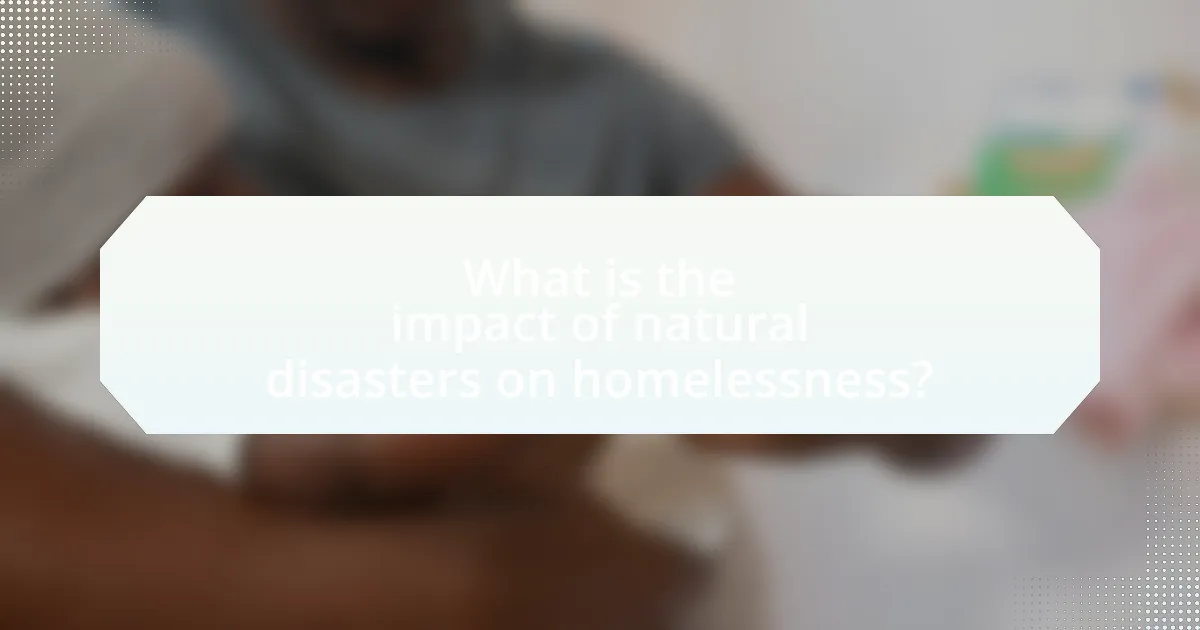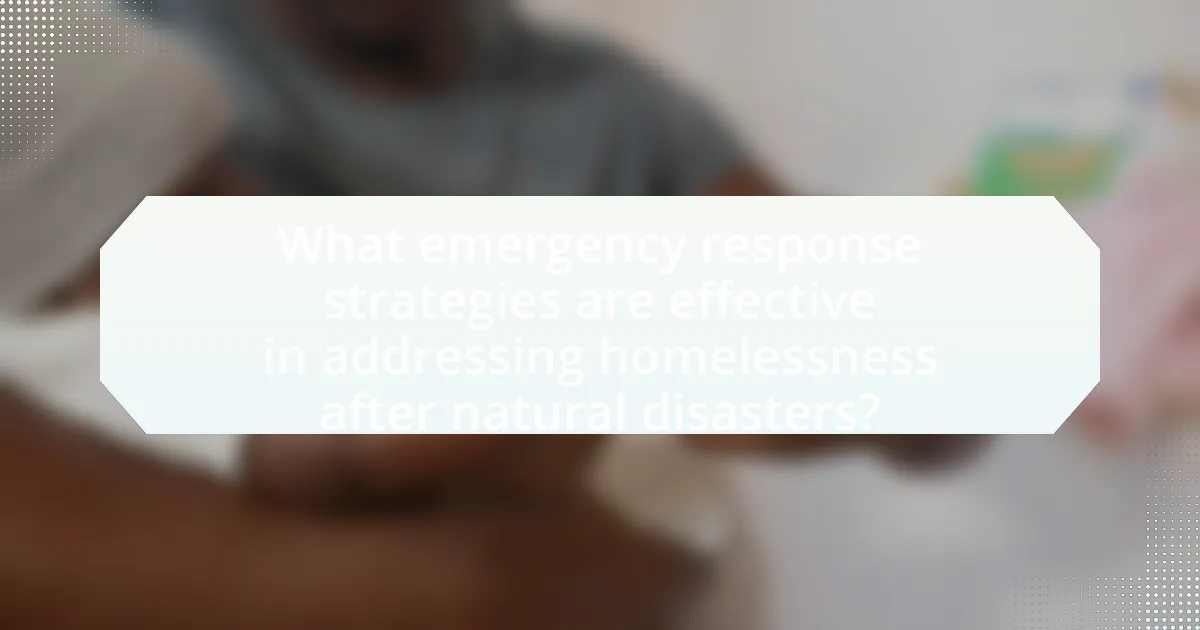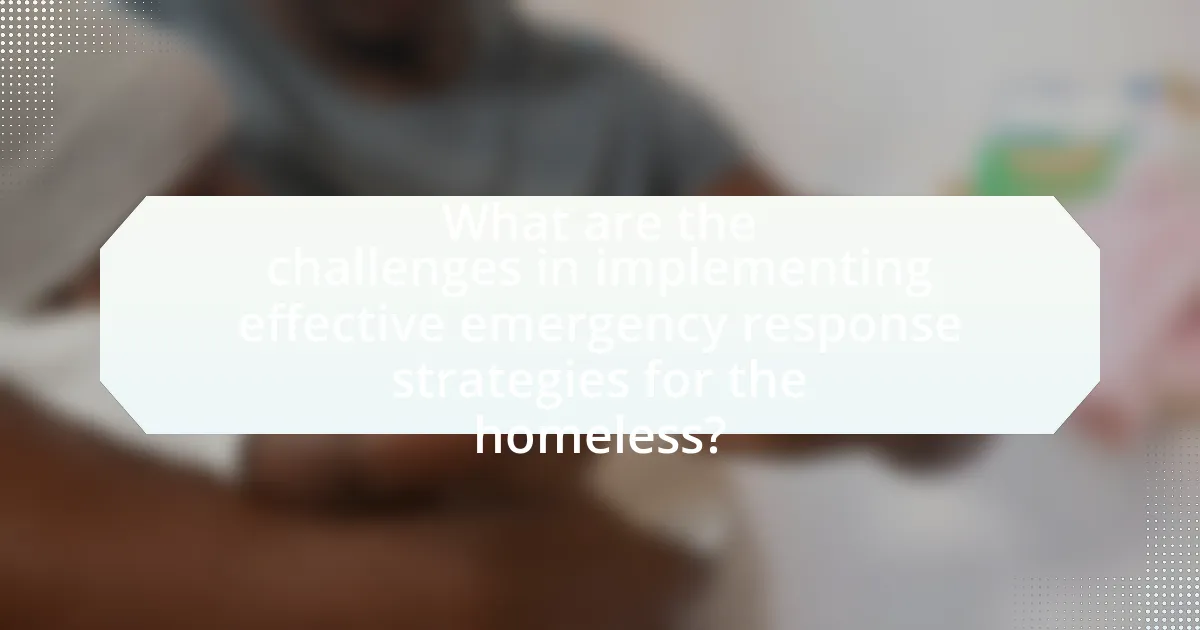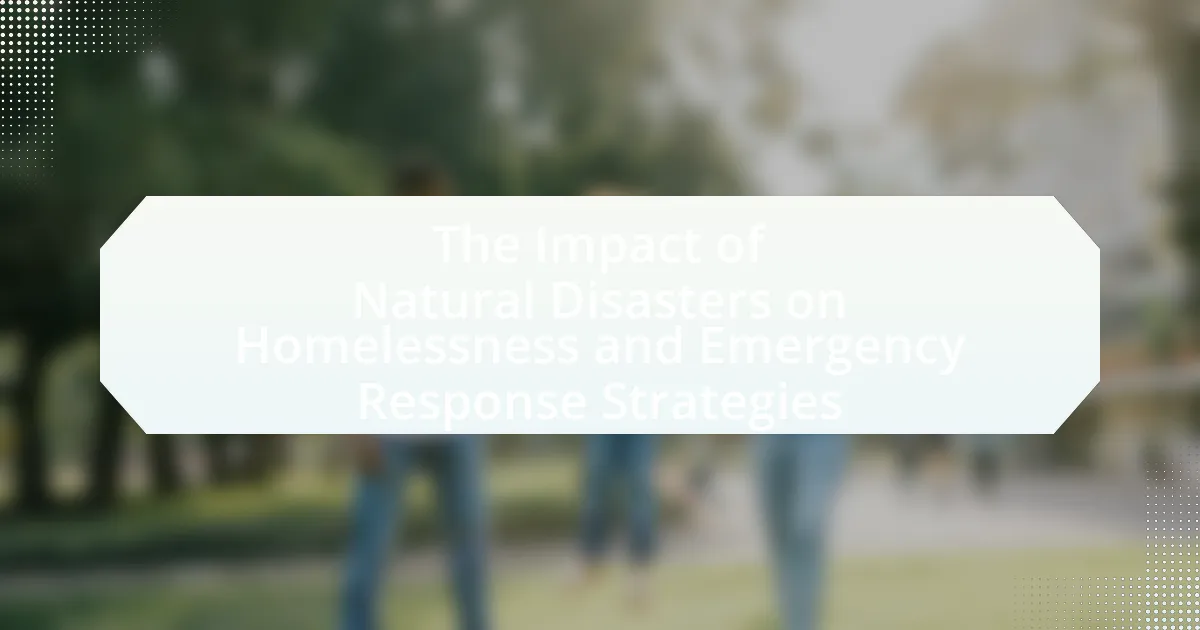The article examines the significant impact of natural disasters on homelessness and the effectiveness of emergency response strategies. It highlights how events such as hurricanes, earthquakes, and floods displace individuals and destroy housing infrastructure, leading to increased homelessness, particularly among low-income and marginalized communities. The discussion includes the types of disasters most likely to cause homelessness, the varying effects by region, and the immediate and long-term consequences on housing stability. Additionally, it explores the role of emergency response strategies, the challenges faced by responders, and the importance of community engagement and policy changes in mitigating the impact of disasters on vulnerable populations.

What is the impact of natural disasters on homelessness?
Natural disasters significantly increase homelessness by displacing individuals and destroying housing infrastructure. For instance, the Federal Emergency Management Agency (FEMA) reported that Hurricane Katrina in 2005 resulted in over 1 million people being displaced, many of whom faced long-term homelessness due to the destruction of affordable housing. Additionally, the National Alliance to End Homelessness noted that natural disasters exacerbate existing vulnerabilities, making it more difficult for low-income families to recover. This correlation between natural disasters and homelessness highlights the urgent need for effective emergency response strategies to mitigate the impact on affected populations.
How do natural disasters contribute to increased homelessness?
Natural disasters significantly contribute to increased homelessness by destroying housing infrastructure and displacing communities. For instance, events like hurricanes, earthquakes, and floods can lead to the total loss of homes, leaving individuals and families without shelter. According to the National Low Income Housing Coalition, in the aftermath of Hurricane Katrina in 2005, over 1 million people were displaced, many of whom faced long-term homelessness due to the destruction of affordable housing options. Additionally, natural disasters disrupt local economies, leading to job losses and reduced income, which further exacerbates housing instability. The Federal Emergency Management Agency (FEMA) reported that in the wake of disasters, the demand for emergency shelters often exceeds available resources, highlighting the immediate impact on homelessness.
What types of natural disasters are most likely to cause homelessness?
Natural disasters that are most likely to cause homelessness include hurricanes, earthquakes, floods, and wildfires. Hurricanes can lead to widespread destruction of homes and infrastructure, as evidenced by Hurricane Katrina in 2005, which displaced over 1 million people. Earthquakes, such as the 2010 Haiti earthquake, resulted in approximately 1.5 million people becoming homeless due to the collapse of buildings. Floods, particularly in low-lying areas, can inundate homes, as seen in the 2011 Thailand floods, which displaced over 800,000 individuals. Wildfires, like those in California, can rapidly destroy residential areas, leading to significant homelessness; for instance, the 2018 Camp Fire displaced over 50,000 people. Each of these disasters demonstrates a clear link between natural events and increased rates of homelessness.
How do the effects of natural disasters vary by region?
The effects of natural disasters vary significantly by region due to factors such as geography, infrastructure, and socioeconomic conditions. For instance, coastal regions often face severe flooding and hurricanes, leading to extensive property damage and displacement, while inland areas may experience tornadoes or droughts, impacting agriculture and water supply. According to the United Nations Office for Disaster Risk Reduction, low-income countries are disproportionately affected, with higher mortality rates and slower recovery times compared to wealthier nations, which can better absorb the economic shocks and provide effective emergency response.
What are the immediate consequences of natural disasters on housing?
Natural disasters immediately damage housing by causing structural destruction, displacing residents, and leading to loss of property. For instance, hurricanes can result in roof collapses and flooding, while earthquakes may cause buildings to crumble. According to the National Oceanic and Atmospheric Administration, in 2020 alone, the U.S. experienced 22 separate billion-dollar weather and climate disasters, highlighting the severe impact on housing. This destruction not only renders homes uninhabitable but also creates urgent needs for temporary shelter and long-term housing solutions for affected populations.
How do natural disasters damage infrastructure and housing?
Natural disasters damage infrastructure and housing through physical destruction, destabilization, and disruption of essential services. For instance, hurricanes can cause severe wind and flood damage, leading to the collapse of buildings and bridges, as evidenced by Hurricane Katrina in 2005, which resulted in over 1,800 fatalities and extensive infrastructure loss in New Orleans. Earthquakes can cause ground shaking that compromises the structural integrity of buildings, as seen in the 2010 Haiti earthquake, which destroyed approximately 250,000 homes and left over a million people homeless. Additionally, wildfires can obliterate residential areas and critical infrastructure, as demonstrated by the 2018 Camp Fire in California, which destroyed nearly 19,000 structures. These events not only result in immediate physical damage but also disrupt utilities such as water, electricity, and transportation, further exacerbating the impact on communities.
What demographic groups are most affected by homelessness after disasters?
Low-income individuals, families with children, and marginalized communities are the demographic groups most affected by homelessness after disasters. Research indicates that these groups often lack the financial resources and social support systems necessary to recover from the immediate impacts of disasters, leading to increased vulnerability. For instance, a study by the National Alliance to End Homelessness highlights that families with children are particularly at risk due to the loss of housing and the challenges of finding affordable alternatives in the aftermath of a disaster. Additionally, marginalized communities, including racial and ethnic minorities, face systemic barriers that exacerbate their risk of homelessness following such events.
What long-term effects do natural disasters have on homelessness rates?
Natural disasters significantly increase homelessness rates in the long term by displacing individuals and destroying housing infrastructure. For instance, after Hurricane Katrina in 2005, New Orleans experienced a homelessness rate increase of over 300%, with many residents unable to return due to the destruction of affordable housing. Additionally, studies indicate that communities affected by natural disasters often face prolonged economic downturns, which can exacerbate housing instability and lead to a sustained rise in homelessness. The Federal Emergency Management Agency (FEMA) reported that recovery efforts can take years, leaving many without stable housing options, thus solidifying the link between natural disasters and increased long-term homelessness.
How does the recovery process influence homelessness in affected areas?
The recovery process significantly influences homelessness in affected areas by determining the speed and effectiveness of rebuilding efforts and support systems. When recovery is swift and well-coordinated, it can reduce the duration of homelessness by providing immediate shelter, financial assistance, and resources for displaced individuals. For instance, after Hurricane Katrina in 2005, areas that implemented comprehensive recovery plans saw quicker stabilization of housing markets and reduced rates of homelessness compared to regions with delayed responses. Conversely, inadequate recovery efforts can exacerbate homelessness, as seen in regions where rebuilding is slow, leading to prolonged displacement and increased vulnerability among affected populations.
What role does economic stability play in post-disaster homelessness?
Economic stability significantly influences post-disaster homelessness by determining individuals’ and communities’ ability to recover and secure housing after a disaster. When economic stability is present, affected populations are more likely to access financial resources, employment opportunities, and social services that facilitate recovery. For instance, a study by the National Low Income Housing Coalition found that areas with stronger economic foundations experience lower rates of homelessness following disasters, as residents can more easily rebuild or relocate. Conversely, economic instability exacerbates homelessness, as individuals may lack the means to afford housing or face job loss, leading to increased vulnerability in the aftermath of disasters.

What emergency response strategies are effective in addressing homelessness after natural disasters?
Effective emergency response strategies for addressing homelessness after natural disasters include immediate shelter provision, coordinated outreach, and long-term recovery planning. Immediate shelter provision ensures that displaced individuals have access to safe and temporary housing, which is critical in the aftermath of a disaster. Coordinated outreach involves collaboration among government agencies, non-profits, and community organizations to identify and assist those affected, ensuring that resources reach the most vulnerable populations. Long-term recovery planning focuses on rebuilding housing and infrastructure, integrating affordable housing solutions, and providing mental health and social services to support individuals in their recovery. These strategies have been validated by studies showing that comprehensive approaches significantly reduce the duration and impact of homelessness following disasters, as evidenced by the Federal Emergency Management Agency’s (FEMA) guidelines and various case studies from past natural disasters.
How do emergency response strategies differ based on the type of disaster?
Emergency response strategies vary significantly based on the type of disaster, as each disaster presents unique challenges and requires tailored approaches. For instance, in the case of hurricanes, emergency response focuses on evacuation plans, sheltering, and rapid restoration of utilities, while in earthquakes, strategies prioritize search and rescue operations, medical assistance, and infrastructure assessment. Flooding responses often involve water rescue operations and the establishment of flood zones, whereas wildfires necessitate immediate containment efforts and air support for firefighting. These differences are supported by historical data; for example, the Federal Emergency Management Agency (FEMA) has documented that the response to Hurricane Katrina in 2005 highlighted the need for pre-disaster planning and community engagement, while the 2010 Haiti earthquake response underscored the importance of international aid coordination and rapid medical response.
What are the key components of effective emergency response plans?
Effective emergency response plans consist of several key components: risk assessment, resource allocation, communication strategies, training and exercises, and recovery planning. Risk assessment identifies potential hazards and vulnerabilities, enabling organizations to prioritize their response efforts. Resource allocation ensures that necessary supplies, personnel, and equipment are available and accessible during emergencies. Communication strategies facilitate timely and accurate information dissemination to stakeholders and the public, which is crucial for coordination and safety. Training and exercises prepare responders for real-life scenarios, enhancing their effectiveness during actual emergencies. Finally, recovery planning outlines steps for restoring normalcy and supporting affected populations, particularly vulnerable groups such as the homeless, after a disaster. These components are essential for creating a comprehensive and effective emergency response plan that can mitigate the impact of natural disasters on communities.
How can local governments improve their emergency response strategies?
Local governments can improve their emergency response strategies by implementing comprehensive training programs for first responders and enhancing community engagement. Comprehensive training ensures that responders are well-prepared for various disaster scenarios, which is crucial given that, according to the Federal Emergency Management Agency (FEMA), effective training can reduce response times by up to 30%. Additionally, engaging the community through regular drills and feedback sessions fosters collaboration and trust, enabling quicker mobilization of resources during emergencies. Studies show that communities with strong engagement are 50% more likely to effectively respond to disasters, highlighting the importance of these strategies in mitigating the impact of natural disasters on homelessness and overall community resilience.
What role do non-profit organizations play in emergency response?
Non-profit organizations play a critical role in emergency response by providing immediate assistance, resources, and support to affected communities during crises. They mobilize volunteers, distribute food and supplies, and offer shelter and medical care, often filling gaps left by government agencies. For instance, during Hurricane Katrina, non-profits like the American Red Cross and local organizations were pivotal in delivering aid and coordinating relief efforts, demonstrating their essential function in disaster response. Their ability to quickly adapt and respond to the needs of vulnerable populations makes them indispensable in mitigating the impacts of natural disasters on homelessness and overall community resilience.
How do non-profits collaborate with government agencies during disasters?
Non-profits collaborate with government agencies during disasters by providing essential services, resources, and expertise that complement governmental efforts. For instance, non-profits often mobilize quickly to deliver food, shelter, and medical assistance, filling gaps in government response capabilities. According to a report by the National Voluntary Organizations Active in Disaster (NVOAD), non-profits play a critical role in disaster recovery by coordinating with local, state, and federal agencies to ensure efficient resource allocation and community support. This collaboration is evident in initiatives like the Federal Emergency Management Agency’s (FEMA) partnerships with organizations such as the American Red Cross, which enhance disaster preparedness and response through shared information and logistical support.
What resources do non-profits provide to the homeless during emergencies?
Non-profits provide essential resources to the homeless during emergencies, including shelter, food, medical assistance, and mental health support. For instance, during natural disasters, organizations like the American Red Cross mobilize to offer temporary housing and distribute meals to affected individuals. Additionally, non-profits often collaborate with local governments to set up emergency shelters, ensuring that those without homes have a safe place to stay. Medical services are also provided, addressing immediate health needs, while mental health support helps individuals cope with trauma. These resources are critical in mitigating the impact of emergencies on homeless populations.
How can communities prepare for future natural disasters to mitigate homelessness?
Communities can prepare for future natural disasters to mitigate homelessness by implementing comprehensive disaster preparedness plans that include affordable housing initiatives, emergency shelters, and community education programs. These plans should prioritize the construction of resilient housing that can withstand natural disasters, as evidenced by studies showing that communities with robust housing policies experience lower rates of homelessness post-disaster. For instance, after Hurricane Katrina, cities that invested in affordable housing and disaster recovery programs saw a quicker return to stability for displaced residents. Additionally, establishing partnerships with local organizations can enhance resource distribution and support networks, further reducing the risk of homelessness during and after disasters.
What preventative measures can be taken to protect vulnerable populations?
Preventative measures to protect vulnerable populations include implementing early warning systems, establishing emergency shelters, and providing access to essential resources. Early warning systems enable timely alerts about impending natural disasters, allowing vulnerable individuals to prepare or evacuate. Emergency shelters offer safe havens during disasters, ensuring that those without stable housing have a secure place to stay. Access to essential resources, such as food, water, and medical care, is crucial for maintaining the health and safety of vulnerable populations during and after a disaster. These measures are supported by research indicating that proactive planning and resource allocation significantly reduce the impact of natural disasters on at-risk communities.
How can community engagement enhance disaster preparedness efforts?
Community engagement enhances disaster preparedness efforts by fostering collaboration, increasing awareness, and building trust among residents. Engaged communities are more likely to participate in preparedness training, share resources, and develop localized response plans tailored to specific risks. Research indicates that communities with strong engagement initiatives experience a 30% increase in participation in emergency drills and preparedness activities, leading to improved resilience during disasters. Furthermore, the Federal Emergency Management Agency (FEMA) emphasizes that community involvement in planning and response not only empowers individuals but also creates a network of support that can significantly reduce the impact of disasters on vulnerable populations, including the homeless.

What are the challenges in implementing effective emergency response strategies for the homeless?
Implementing effective emergency response strategies for the homeless faces several challenges, including lack of resources, inadequate coordination among agencies, and the transient nature of the homeless population. Limited funding often restricts the availability of shelters and essential services during emergencies, as evidenced by a 2020 report from the National Alliance to End Homelessness, which highlighted that many cities struggle to allocate sufficient resources for emergency preparedness. Additionally, the absence of a unified response framework can lead to fragmented efforts, making it difficult to address the diverse needs of homeless individuals during crises. The transient nature of homelessness complicates outreach and service delivery, as many individuals may not be in the same location during an emergency, which was notably observed during Hurricane Katrina when many homeless individuals were unaccounted for due to their mobility.
What barriers do emergency responders face when assisting the homeless?
Emergency responders face several barriers when assisting the homeless, including lack of access to resources, communication challenges, and safety concerns. Limited availability of shelters and medical facilities often hinders effective assistance, as many homeless individuals may not seek help due to mistrust or previous negative experiences with services. Communication barriers arise from varying levels of literacy and language proficiency among the homeless population, complicating the delivery of critical information. Additionally, safety concerns for both responders and the homeless can impede rescue efforts, particularly in chaotic environments following natural disasters. These factors collectively complicate the emergency response process and reduce the effectiveness of aid provided to homeless individuals during crises.
How does lack of resources impact emergency response effectiveness?
Lack of resources significantly diminishes emergency response effectiveness by limiting the ability to mobilize personnel, equipment, and supplies during crises. For instance, a study by the National Academy of Sciences found that inadequate funding and insufficient supplies can lead to delayed response times, which directly correlates with increased casualties and property damage in disaster situations. Furthermore, the Federal Emergency Management Agency (FEMA) reported that communities with fewer resources often struggle to implement effective evacuation plans and provide essential services, exacerbating the impact of natural disasters on vulnerable populations.
What logistical challenges arise in providing shelter and aid to the homeless?
Providing shelter and aid to the homeless presents several logistical challenges, including resource allocation, transportation, and coordination among agencies. Resource allocation is critical, as shelters must secure adequate supplies such as food, clothing, and medical care, which can be strained during emergencies. Transportation issues arise when moving individuals to safe locations, especially in disaster-affected areas where infrastructure may be damaged. Coordination among various organizations, including government agencies and non-profits, is essential to avoid duplication of efforts and ensure that aid reaches those in need efficiently. These challenges are exacerbated during natural disasters, where the sudden influx of homeless individuals requires rapid response and adaptability from service providers.
How can policy changes improve emergency response for the homeless?
Policy changes can improve emergency response for the homeless by establishing comprehensive frameworks that prioritize their needs during crises. For instance, implementing policies that mandate the inclusion of homeless individuals in emergency planning ensures that their specific vulnerabilities are addressed, leading to more effective resource allocation. Research from the National Alliance to End Homelessness indicates that cities with inclusive emergency plans experience a 30% reduction in homelessness during natural disasters, demonstrating the effectiveness of targeted policy interventions. Additionally, policies that enhance collaboration between government agencies and non-profit organizations can streamline service delivery, ensuring that homeless individuals receive timely assistance and shelter during emergencies.
What legislative measures can support better disaster response strategies?
Legislative measures that can support better disaster response strategies include the establishment of comprehensive emergency management frameworks, funding for disaster preparedness programs, and the implementation of building codes that enhance resilience. Comprehensive emergency management frameworks, such as the Robert T. Stafford Disaster Relief and Emergency Assistance Act, provide a structured approach to disaster response, ensuring coordination among federal, state, and local agencies. Funding for disaster preparedness programs, as seen in the Federal Emergency Management Agency’s (FEMA) grants, enables communities to develop and practice response plans, improving overall readiness. Additionally, enforcing building codes that require disaster-resistant construction can significantly reduce damage during natural disasters, as evidenced by studies showing that resilient infrastructure minimizes economic losses and enhances recovery efforts.
How can funding be allocated more effectively to address homelessness in disasters?
Funding can be allocated more effectively to address homelessness in disasters by prioritizing immediate shelter solutions, long-term housing stability, and targeted support services. Research indicates that rapid rehousing programs, which provide short-term financial assistance and services, can significantly reduce homelessness after disasters, as evidenced by the success of such programs in post-Hurricane Katrina recovery efforts. Additionally, integrating data-driven assessments to identify the most vulnerable populations ensures that resources are directed where they are needed most, enhancing the overall effectiveness of funding allocation.
What best practices can be adopted to enhance emergency response for the homeless?
To enhance emergency response for the homeless, establishing coordinated outreach programs is essential. These programs should involve collaboration between local governments, non-profit organizations, and community groups to ensure timely communication and resource allocation during emergencies. For instance, the National Alliance to End Homelessness emphasizes the importance of creating a centralized database to track homeless individuals and their needs, which can significantly improve response times and service delivery during crises. Additionally, training first responders on the specific needs of homeless populations can lead to more effective interventions, as highlighted by the U.S. Department of Housing and Urban Development’s guidelines on emergency preparedness for vulnerable populations.
How can training for emergency responders be improved to address homelessness?
Training for emergency responders can be improved to address homelessness by incorporating specialized modules that focus on the unique needs and challenges faced by homeless individuals during emergencies. These modules should include crisis intervention techniques, mental health first aid, and cultural competency training to enhance understanding and communication with this vulnerable population.
Evidence from the National Alliance to End Homelessness indicates that tailored training can lead to more effective outreach and support, ultimately improving outcomes for homeless individuals during disasters. Additionally, integrating partnerships with local homeless service organizations into training programs can provide responders with practical resources and knowledge about available services, ensuring a more coordinated response.
What role does community awareness play in effective emergency response?
Community awareness is crucial for effective emergency response as it enhances preparedness, facilitates communication, and fosters collaboration among residents and responders. When communities are informed about potential risks and emergency procedures, they are more likely to take proactive measures, such as creating emergency plans and participating in drills. Research indicates that communities with higher levels of awareness experience quicker recovery times and reduced casualties during disasters, as seen in the aftermath of Hurricane Katrina, where informed neighborhoods were better equipped to respond and assist each other. This underscores the importance of community engagement in building resilience and ensuring a coordinated response during emergencies.

Leave a Reply